dashboard Alfa Romeo Giulietta 2012 Owner handbook (in English)
[x] Cancel search | Manufacturer: ALFA ROMEO, Model Year: 2012, Model line: Giulietta, Model: Alfa Romeo Giulietta 2012Pages: 297, PDF Size: 9.37 MB
Page 126 of 297
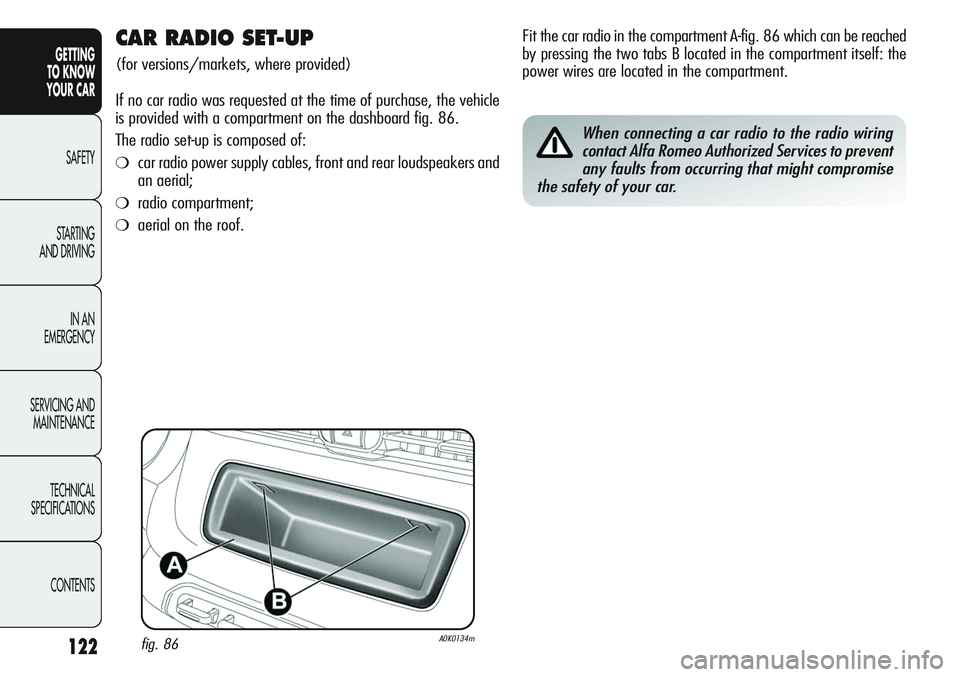
122
GETTING
TO KNOW
YOUR CAR
SAFETY
STARTING
AND DRIVING
IN AN
EMERGENCY
SERVICING AND
MAINTENANCE
TECHNICAL
SPECIFICATIONS
CONTENTS
CAR RADIO SET-UP
(for versions/markets, where provided)
If no car radio was requested at the time of purchase, the vehicle
is provided with a compartment on the dashboard fig. 86.
The radio set-up is composed of:
❍car radio power supply cables, front and rear loudspeakers and
an aerial;
❍radio compartment;
❍aerial on the roof.
fig. 86A0K0134m
Fit the car radio in the compartment A-fig. 86 which can be reached
by pressing the two tabs B located in the compartment itself: the
power wires are located in the compartment.
When connecting a car radio to the radio wiring
contact Alfa Romeo Authorized Services to prevent
any faults from occurring that might compromise
the safety of your car.
Page 142 of 297
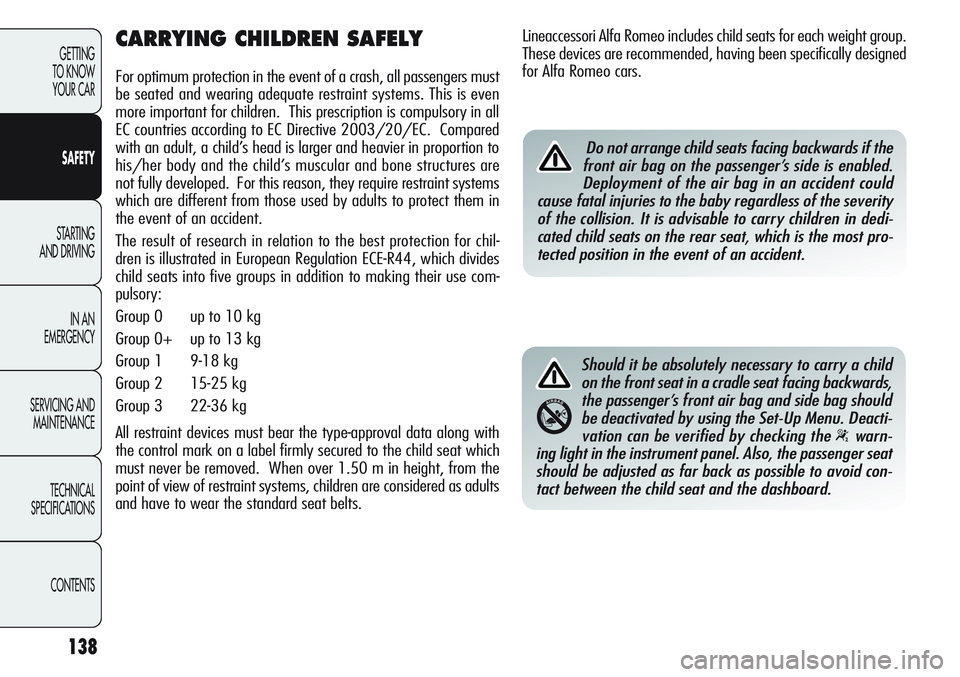
138
GETTING
TO KNOW
YOUR CAR
SAFETY
STARTING
AND DRIVING
IN AN
EMERGENCY
SERVICING AND
MAINTENANCE
TECHNICAL
SPECIFICATIONS
CONTENTS
CARRYING CHILDREN SAFELY
For optimum protection in the event of a crash, all passengers must
be seated and wearing adequate restraint systems. This is even
more important for children. This prescription is compulsory in all
EC countries according to EC Directive 2003/20/EC. Compared
with an adult, a child’s head is larger and heavier in proportion to
his/her body and the child’s muscular and bone structures are
not fully developed. For this reason, they require restraint systems
which are different from those used by adults to protect them in
the event of an accident.
The result of research in relation to the best protection for chil-
dren is illustrated in European Regulation ECE-R44, which divides
child seats into five groups in addition to making their use com-
pulsory:
Group 0 up to 10 kg
Group 0+ up to 13 kg
Group 1 9-18 kg
Group 2 15-25 kg
Group 3 22-36 kg
All restraint devices must bear the type-approval data along with
the control mark on a label firmly secured to the child seat which
must never be removed. When over 1.50 m in height, from the
point of view of restraint systems, children are considered as adults
and have to wear the standard seat belts.
Should it be absolutely necessary to carry a child
on the front seat in a cradle seat facing backwards,
the passenger’s front air bag and side bag should
be deactivated by using the Set-Up Menu. Deacti-
vation can be verified by checking the
“warn-
ing light in the instrument panel. Also, the passenger seat
should be adjusted as far back as possible to avoid con-
tact between the child seat and the dashboard.
Lineaccessori Alfa Romeo includes child seats for each weight group.
These devices are recommended, having been specifically designed
for Alfa Romeo cars.
Do not arrange child seats facing backwards if the
front air bag on the passenger’s side is enabled.
Deployment of the air bag in an accident could
cause fatal injuries to the baby regardless of the severity
of the collision. It is advisable to carry children in dedi-
cated child seats on the rear seat, which is the most pro-
tected position in the event of an accident.
Page 150 of 297
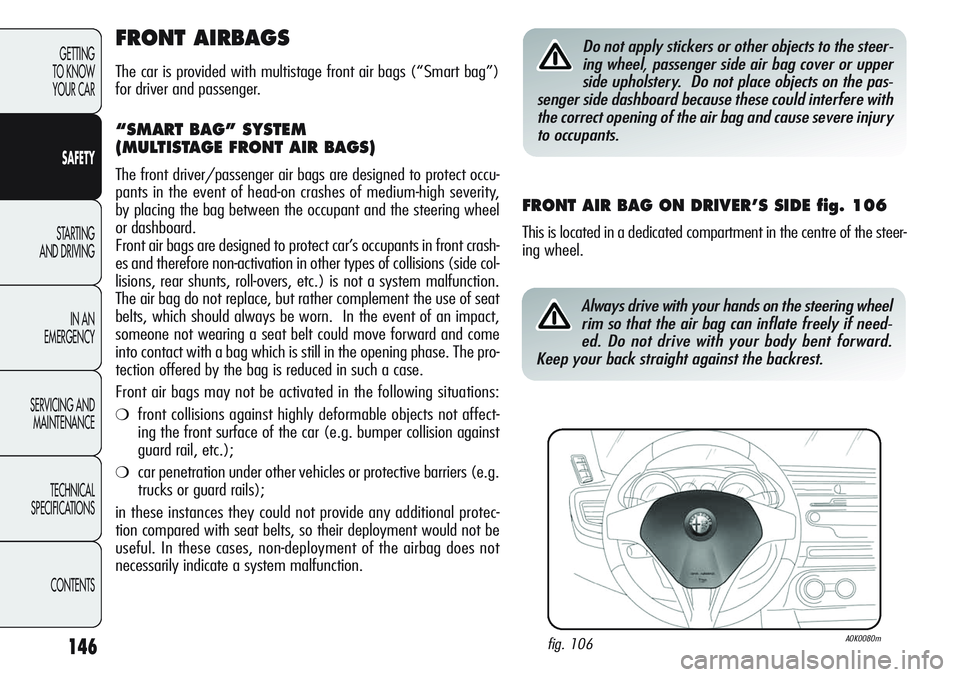
146
GETTING
TO KNOW
YOUR CAR
SAFETY
STARTING
AND DRIVING
IN AN
EMERGENCY
SERVICING AND
MAINTENANCE
TECHNICAL
SPECIFICATIONS
CONTENTS
FRONT AIRBAGS
The car is provided with multistage front air bags (“Smart bag”)
for driver and passenger.
“SMART BAG” SYSTEM
(MULTISTAGE FRONT AIR BAGS)
The front driver/passenger air bags are designed to protect occu-
pants in the event of head-on crashes of medium-high severity,
by placing the bag between the occupant and the steering wheel
or dashboard.
Front air bags are designed to protect car’s occupants in front crash-
es and therefore non-activation in other types of collisions (side col-
lisions, rear shunts, roll-overs, etc.) is not a system malfunction.
The air bag do not replace, but rather complement the use of seat
belts, which should always be worn. In the event of an impact,
someone not wearing a seat belt could move forward and come
into contact with a bag which is still in the opening phase. The pro-
tection offered by the bag is reduced in such a case.
Front air bags may not be activated in the following situations:
❍front collisions against highly deformable objects not affect-
ing the front surface of the car (e.g. bumper collision against
guard rail, etc.);
❍car penetration under other vehicles or protective barriers (e.g.
trucks or guard rails);
in these instances they could not provide any additional protec-
tion compared with seat belts, so their deployment would not be
useful. In these cases, non-deployment of the airbag does not
necessarily indicate a system malfunction.
FRONT AIR BAG ON DRIVER’S SIDE fig. 106
This is located in a dedicated compartment in the centre of the steer-
ing wheel.
Do not apply stickers or other objects to the steer-
ing wheel, passenger side air bag cover or upper
side upholstery. Do not place objects on the pas-
senger side dashboard because these could interfere with
the correct opening of the air bag and cause severe injury
to occupants.
fig. 106A0K0080m
Always drive with your hands on the steering wheel
rim so that the air bag can inflate freely if need-
ed. Do not drive with your body bent forward.
Keep your back straight against the backrest.
Page 151 of 297
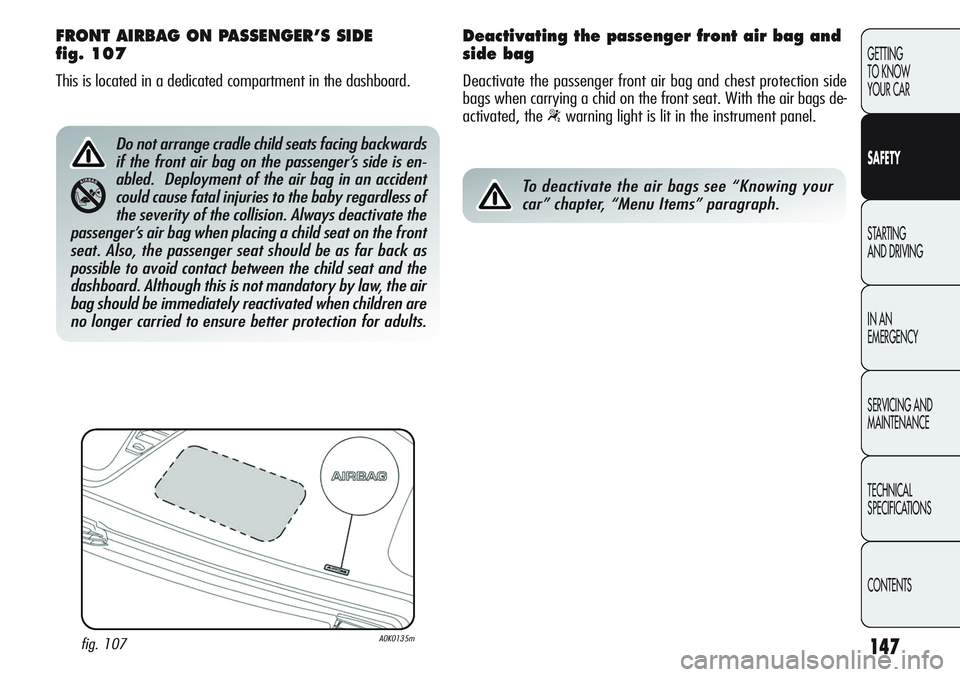
147
GETTING
TO KNOW
YOUR CAR
SAFETY
STARTING
AND DRIVING
IN AN
EMERGENCY
SERVICING AND
MAINTENANCE
TECHNICAL
SPECIFICATIONS
CONTENTS
FRONT AIRBAG ON PASSENGER’S SIDE
fig. 107
This is located in a dedicated compartment in the dashboard.
fig. 107A0K0135m
Do not arrange cradle child seats facing backwards
if the front air bag on the passenger’s side is en-
abled. Deployment of the air bag in an accident
could cause fatal injuries to the baby regardless of
the severity of the collision. Always deactivate the
passenger’s air bag when placing a child seat on the front
seat. Also, the passenger seat should be as far back as
possible to avoid contact between the child seat and the
dashboard. Although this is not mandatory by law, the air
bag should be immediately reactivated when children are
no longer carried to ensure better protection for adults.
To deactivate the air bags see “Knowing your
car” chapter, “Menu Items” paragraph.
Deactivating the passenger front air bag and
side bag
Deactivate the passenger front air bag and chest protection side
bags when carrying a chid on the front seat. With the air bags de-
activated, the
“warning light is lit in the instrument panel.
Page 173 of 297
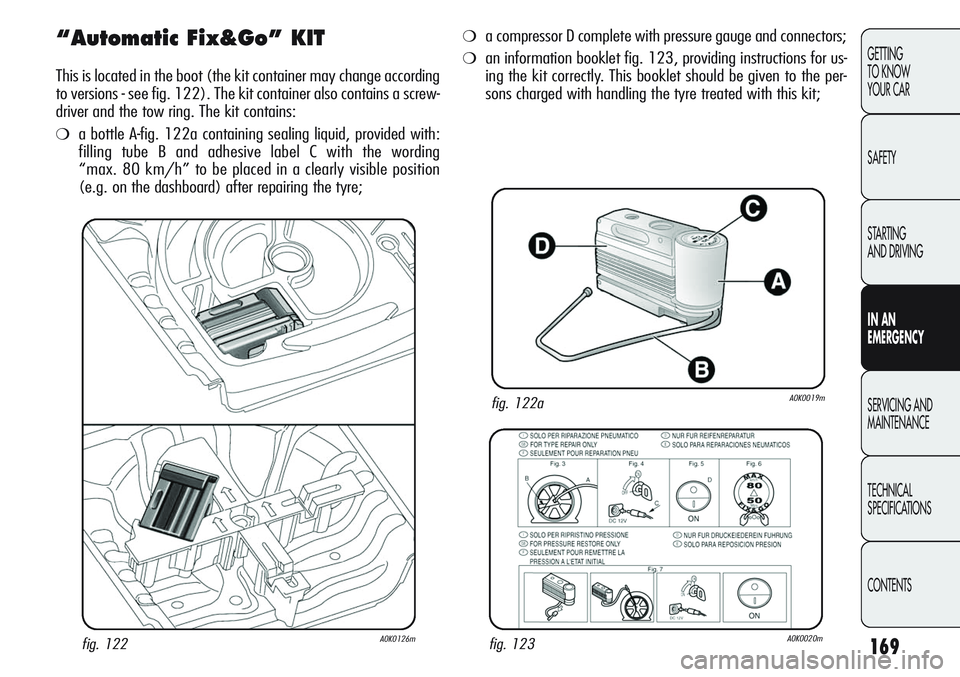
169
GETTING
TO KNOW
YOUR CAR
SAFETY
STARTING
AND DRIVING
IN AN
EMERGENCY
SERVICING AND
MAINTENANCE
TECHNICAL
SPECIFICATIONS
CONTENTS
“Automatic Fix&Go” KIT
This is located in the boot (the kit container may change according
to versions - see fig. 122). The kit container also contains a screw-
driver and the tow ring. The kit contains:
❍a bottle A-fig. 122a containing sealing liquid, provided with:
filling tube B and adhesive label C with the wording
“max. 80 km/h” to be placed in a clearly visible position
(e.g. on the dashboard) after repairing the tyre;
fig. 122aA0K0019m
fig. 122A0K0126mfig. 123A0K0020m
❍a compressor D complete with pressure gauge and connectors;
❍an information booklet fig. 123, providing instructions for us-
ing the kit correctly. This booklet should be given to the per-
sons charged with handling the tyre treated with this kit;
Page 192 of 297
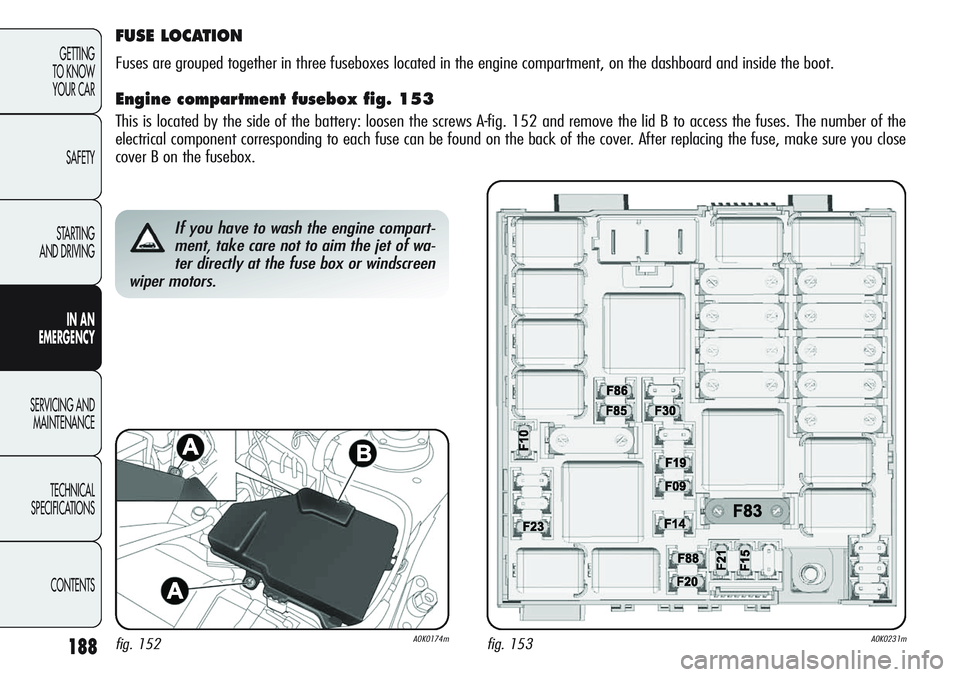
188
GETTING
TO KNOW
YOUR CAR
SAFETY
STARTING
AND DRIVING
IN AN
EMERGENCY
SERVICING AND
MAINTENANCE
TECHNICAL
SPECIFICATIONS
CONTENTS
If you have to wash the engine compart-
ment, take care not to aim the jet of wa-
ter directly at the fuse box or windscreen
wiper motors.
FUSE LOCATION
Fuses are grouped together in three fuseboxes located in the engine compartment, on the dashboard and inside the boot.
Engine compartment fusebox fig. 153
This is located by the side of the battery: loosen the screws A-fig. 152 and remove the lid B to access the fuses. The number of the
electrical component corresponding to each fuse can be found on the back of the cover. After replacing the fuse, make sure you close
cover B on the fusebox.
fig. 152A0K0174mfig. 153A0K0231m
Page 193 of 297
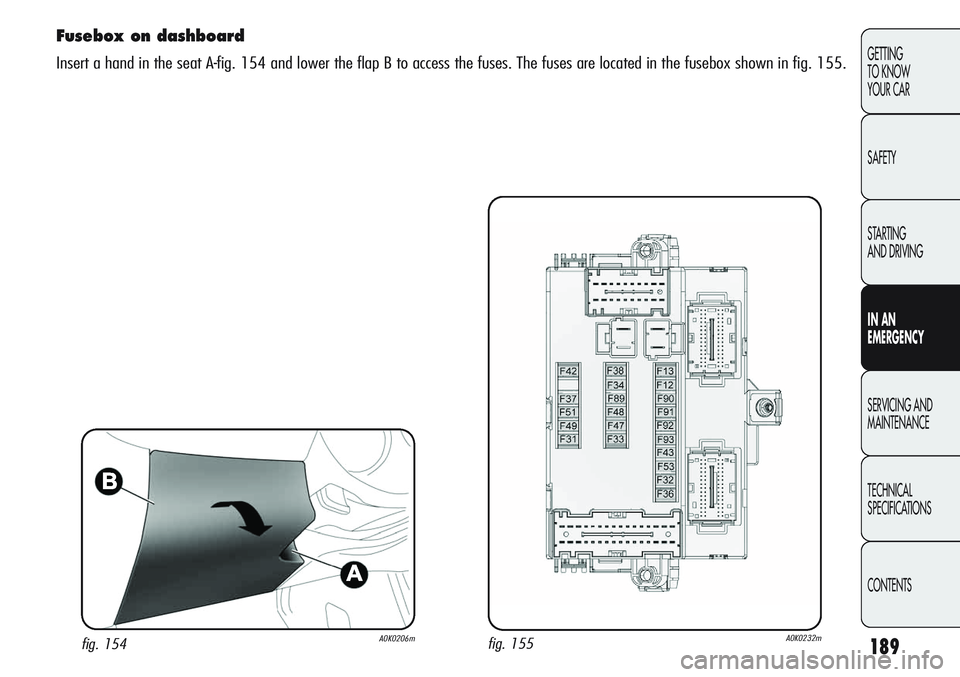
189
GETTING
TO KNOW
YOUR CAR
SAFETY
STARTING
AND DRIVING
IN AN
EMERGENCY
SERVICING AND
MAINTENANCE
TECHNICAL
SPECIFICATIONS
CONTENTS
Fusebox on dashboard
Insert a hand in the seat A-fig. 154 and lower the flap B to access the fuses. The fuses are located in the fusebox shown in fig. 155.
fig. 154A0K0206mfig. 155A0K0232m
Page 209 of 297
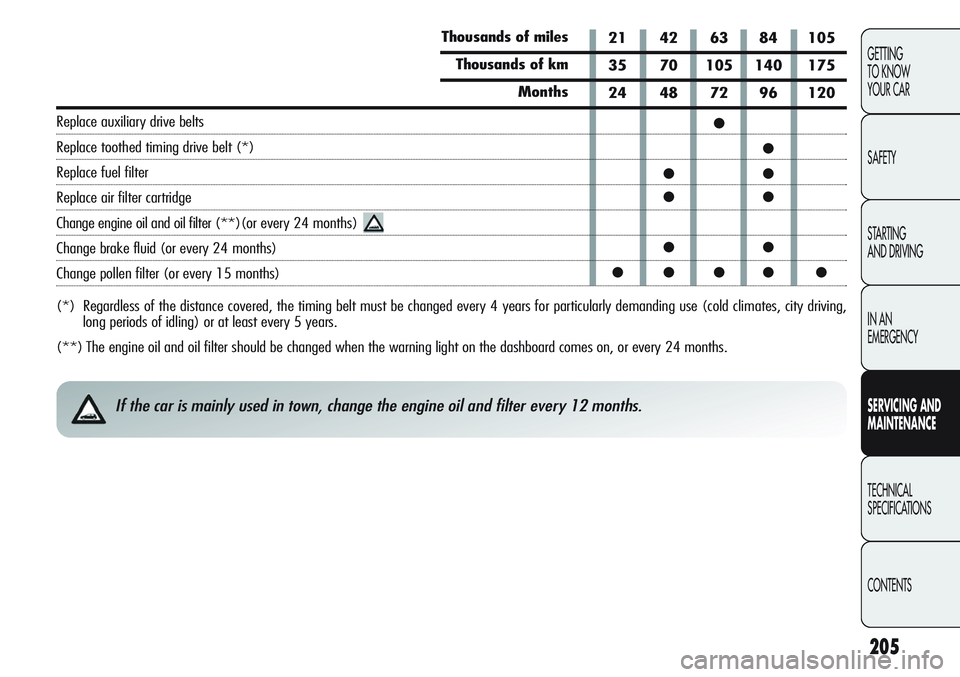
205
GETTING
TO KNOW
YOUR CAR
SAFETY
STARTING
AND DRIVING
IN AN
EMERGENCY
SERVICING AND
MAINTENANCE
TECHNICAL
SPECIFICATIONS
CONTENTS
21 42 63 84 105
35 70 105 140 175
24 48 72 96 120
●
●
●●
●●
●●
●●●● ●
Thousands of miles
Thousands of km
Months
Replace auxiliary drive belts
Replace toothed timing drive belt (*)
Replace fuel filter
Replace air filter cartridge
Change engine oil and oil filter (**)(or every 24 months)
Change brake fluid (or every 24 months)
Change pollen filter (or every 15 months)
(*) Regardless of the distance covered, the timing belt must be changed every 4 years for particularly demanding use (cold climates, city driving,
long periods of idling) or at least every 5 years.
(**) The engine oil and oil filter should be changed when the warning light on the dashboard comes on, or every 24 months.
If the car is mainly used in town, change the engine oil and filter every 12 months.
Page 252 of 297
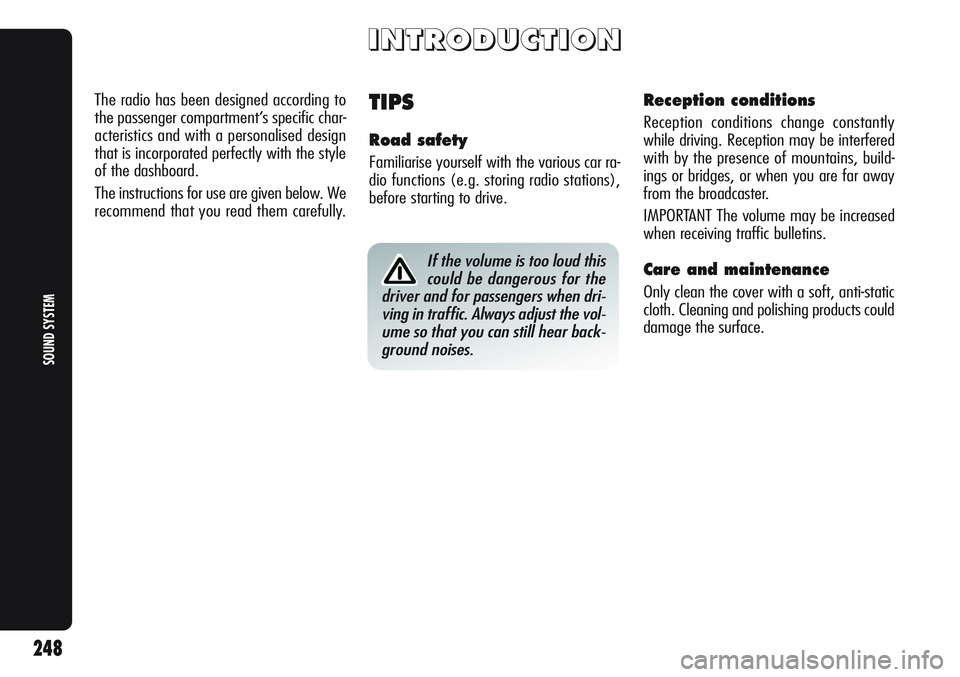
I I
N N
T T
R R
O O
D D
U U
C C
T T
I I
O O
N N
TIPS
Road safety
Familiarise yourself with the various car ra-
dio functions (e.g. storing radio stations),
before starting to drive. The radio has been designed according to
the passenger compartment’s specific char-
acteristics and with a personalised design
that is incorporated perfectly with the style
of the dashboard.
The instructions for use are given below. We
recommend that you read them carefully.
Reception conditions
Reception conditions change constantly
while driving. Reception may be interfered
with by the presence of mountains, build-
ings or bridges, or when you are far away
from the broadcaster.
IMPORTANT The volume may be increased
when receiving traffic bulletins.
Care and maintenance
Only clean the cover with a soft, anti-static
cloth. Cleaning and polishing products could
damage the surface.
If the volume is too loud this
could be dangerous for the
driver and for passengers when dri-
ving in traffic. Always adjust the vol-
ume so that you can still hear back-
ground noises.
SOUND SYSTEM
248
Page 254 of 297
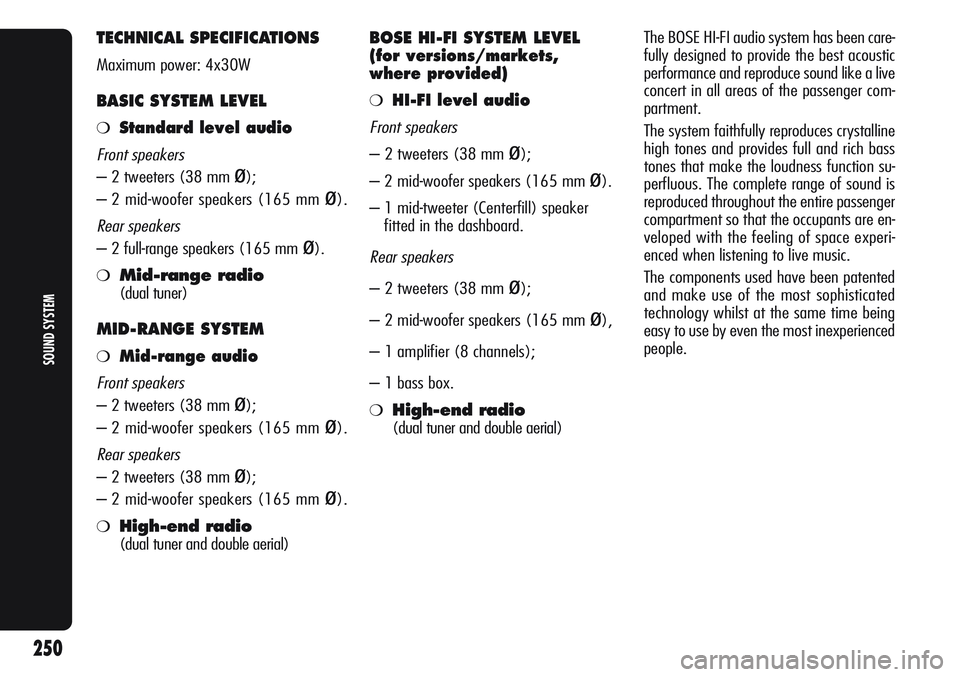
TECHNICAL SPECIFICATIONS
Maximum power: 4x30W
BASIC SYSTEM LEVEL
❍Standard level audio
Front speakers
– 2 tweeters (38 mm ø);
– 2 mid-woofer speakers (165 mm
ø).
Rear speakers
– 2 full-range speakers (165 mm ø).
❍Mid-range radio
(dual tuner)
MID-RANGE SYSTEM
❍Mid-range audio
Front speakers
– 2 tweeters (38 mm ø);
– 2 mid-woofer speakers (165 mm
ø).
Rear speakers
– 2 tweeters (38 mm ø);
– 2 mid-woofer speakers (165 mm
ø).
❍High-end radio
(dual tuner and double aerial)
BOSE HI-FI SYSTEM LEVEL
(for versions/markets,
where provided)
❍HI-FI level audio
Front speakers
– 2 tweeters (38 mm ø);
– 2 mid-woofer speakers (165 mm
ø).
– 1 mid-tweeter (Centerfill) speaker
fitted in the dashboard.
Rear speakers
– 2 tweeters (38 mm ø);
– 2 mid-woofer speakers (165 mm
ø),
– 1 amplifier (8 channels);
– 1 bass box.
❍High-end radio
(dual tuner and double aerial)The BOSE HI-FI audio system has been care-
fully designed to provide the best acoustic
performance and reproduce sound like a live
concert in all areas of the passenger com-
partment.
The system faithfully reproduces crystalline
high tones and provides full and rich bass
tones that make the loudness function su-
perfluous. The complete range of sound is
reproduced throughout the entire passenger
compartment so that the occupants are en-
veloped with the feeling of space experi-
enced when listening to live music.
The components used have been patented
and make use of the most sophisticated
technology whilst at the same time being
easy to use by even the most inexperienced
people.
SOUND SYSTEM
250